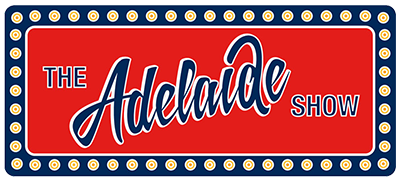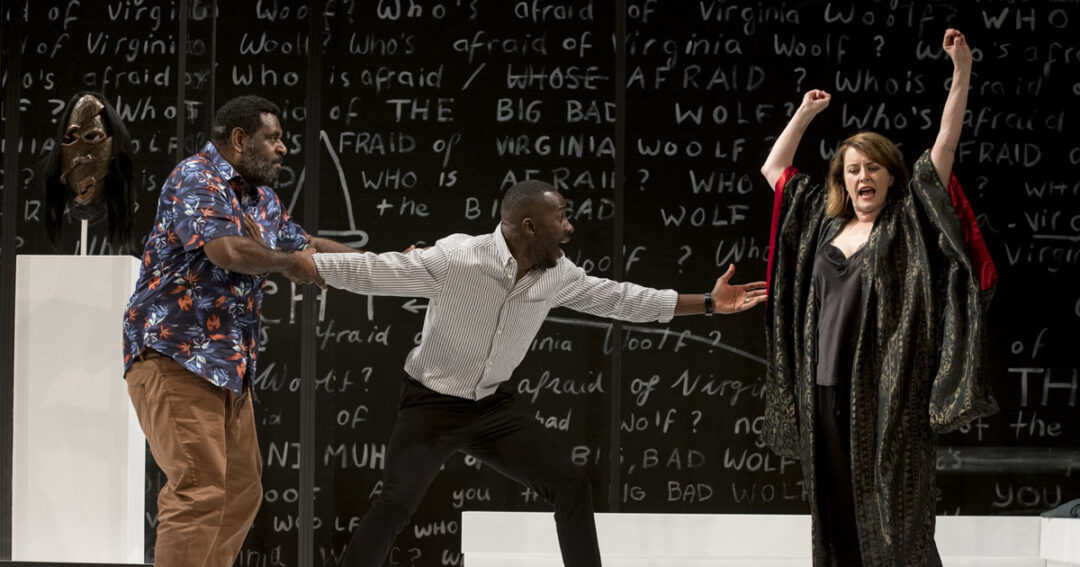State Theatre Company’s interrupted 2021 season, salvaged one of its anticipated productions last night, with the opening of Who’s Afraid Of Virginia Woolf?
Although playwright, Edward Albee, was dutifully given full billing on the program, this production was very much that of director, Margaret Harvey, a proud, First Nations woman of Torres Strait Islander blood who could not help but see and present this classic of the western canon through her cultural lens.
To that end, she deliberately carried out colour-conscious casting, ensuring three members of this four-person cast were BIPOC (Black, Indigenous, and People Of Colour) actors so that she could “make race explicit rather than implicit” in this production.
While Harvey is right to point out that this play was written and set in a time in which the USA was at a boiling point regarding matters of race, the text seems mute on matters of race and is preoccupied with familial and institutional power games and tyrannical social expectations upon Americans at that time to espouse and create nuclear families. We explore that topic through the lens of the key protagonists’ destructive torment of their inability to have children.
The play centres on academic couple, George (Jimi Bani) and Martha (Susan Prior), who have invited their new colleagues, Nick (Rashidi Edward) and Honey (Juanita Navas-Nguyen), over for a friendly drink after an evening event at the university where George and Nick are both professors, and Martha’s dad is the head. The news that guests have been invited is foisted upon George by Martha, as the two of them are having a 2am night cap. George is displeased. Martha relishes her riposte. As the guests arrive and the alcohol flows, the mood and behaviour of the night gets darker and darker.
This is a no-holds-barred master work of terrifying, domestic barbs, laden with cultural references, ferocious wordplay, and acrobatically deliberate obfuscuation. There is cunning in each fight. There is barely a wasted sentence.
Interestingly, this production is staged on a large, black, rectangular stage, bordered by panels of glass and surrounded by a water-filled moat. The three walls adorning the Ailsa Paterson set are emblazoned by school chalkboard-style graffiti; line upon line of “who’s afraid of Virginia Woolf?”, interwoven with twists, thoughts, and extractions. Inside this cage-like space, our actors play. However, given we are not in a homely campus house, the set creates distance between us and the humanity of the characters. They are like moths or butterflies, pinned in a case where they dance through their death throes for us. Our connection to the players is further hampered by the panes of glass at the front of the floating stage for the first part of act one. From Row L, much of the delicious dialogue was lost until thankfully, the front panes were hoisted to the heavens in the first of a number of hoistings throughout the night as windows/barriers were withdrawn, and all sense of order and convention became undermined.
Prior’s performance was a highlight. Her voice had the range and volume one might expect for a character of Martha’s aggressive and capable make up. She owned the stage, even when her character was tumbling downhill in the peaks and troughs of the George and Martha show. Bani held his own as the tortured, impotent, and seething professor, although there were passages in which he was interplaying with Prior while reading text where his projection dropped and the words were lost. Edward conveyed the aspirational professor well, especially in times of high status when he gave us glimpses of greater potential for “fight”. And Navas-Nguyen was classically cloying and fragile in her role as Honey, complete with brittle intonation the more the world became broken.
For this theatre goer, a disposition of colour blindness is practiced as de rigueur, so it was an unusual challenge to have been asked to read race into the production, as opposed to simply watching players play. Late in the production, however, there was a scene when the colour casting injected extra meaning into the text. After disappointing Martha in bed, Nick is dubbed as her “boy” and her “servant”, and commanded to perform menial chores. Suddenly, we have N-word-level racist “optics” in play as a black man is bossed around by a person of white privilege. But then, instead of being left, squirming over this “wrong”, George returns and also piles on; one man of colour treating another as a slave. By this stage, drawing towards the end of our 3-hour journey, we are spent, and already well feasted upon satisfying theatrical fare, so prepare yourself for a marathon banquet of sensory over-indulgence if you do decide to see this production. In fact, George’s words fit well here: “I think we’re having a real good evening, all things considered.”
To answer George, I think we did. We were on guard for more socio-political intrigue but left with our fill of fine writing and some boisterous moments of thespian delights.
With the dust blown off this classic, I think the next move is to get a copy of the 1966 movie and relish the performances that burned this story so deeply into our collective psyche, that an original Australian rendering was spawned, some 50-ish years later.
Who’s Afraid Of Virginial Woolf?, State Theatre Company, Dunstan Playhouse, Jan 27-Feb 6, 2022. Photo: Brett Boardman.

